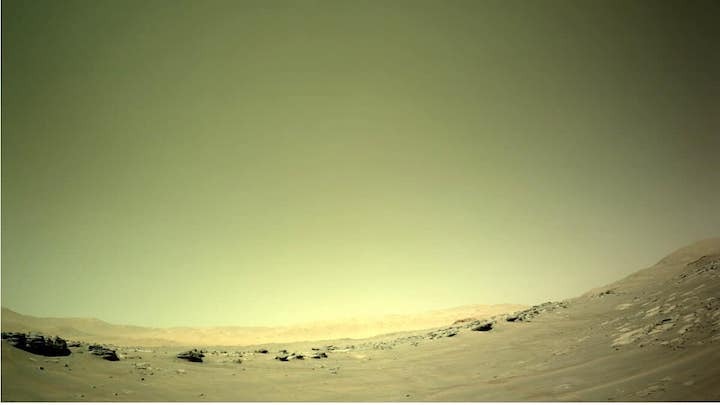6.01.2022
Elementary: SHERLOC discovers exciting signatures in the Red Planet’s rocks.

A photo of the Martian surface taken by the Perseverance rover. Credit: NASA/JPL-Caltech
We’ve known for a few years that Mars has organic, carbon-containing molecules, thanks to the data gathered by the Curiosity rover. Now, Perseverance has added to the tale, with the discovery of more organic compounds in the Jezero Crater.
The molecules are ‘organic’ in the chemical sense – meaning they contain carbon and hydrogen. This doesn’t necessarily mean that they were created by living organisms: there are plenty of non-biological ways to make organic molecules.
The discovery was announced at a meeting of the American Geophysical Union, in December. Researchers from the Perseverance mission also announced that they had determined that the bedrock of the Jezero Crater was probably igneous – meaning it had formed from magma.
The organics were identified with the help of one of Perseverance’s instruments: the Scanning Habitable Environments with Raman & Luminescence for Organics & Chemicals, or SHERLOC.
This instrument uses Raman spectroscopy to determine the contents of the rocks. This technique shines visible, or near-visible, light through samples and examines how they scatter light: different molecules will scatter it differently.
“Curiosity also discovered organics at its landing site within Gale Crater,” says Luther Beegle, SHERLOC principal investigator at NASA’s Jet Propulsion Laboratory, US.
“What SHERLOC adds to the story is its capability to map the spatial distribution of organics inside rocks and relate those organics to minerals found there. This helps us understand the environment in which the organics formed.
“More analysis needs to be done to determine the method of production for the identified organics.”
If there is evidence of life in the Jezero crater, it could still be some time before it’s discovered.
“This is a question that may not be solved until the samples are returned to Earth, but the preservation of organics is very exciting,” says Beegle.
“When these samples are returned to Earth, they will be a source of scientific inquiry and discovery for many years.”
Perseverance is collecting rock and atmosphere samples that will be returned to Earth at a later date – the mission to retrieve these samples will launch in 2028 at the earliest.
It’s currently filled and sealed six tubes, out of a maximum of 43. Four of the tubes contain rock cores, one has Martian atmosphere, and one is a reference tube to determine contamination from the rover.
Quelle: COSMOS
